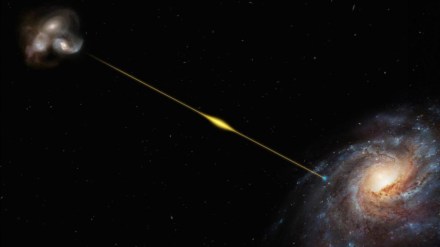Researchers made a groundbreaking discovery as they unearthed a fleeting burst of cosmic radio waves in June last year. This astronomical phenomenon, known as a “fast radio burst” (FRB), lasted a mere fraction of a millisecond. What set this particular FRB apart was its unparalleled distance; it emerged from a galaxy so remote that the waves had journeyed across the universe for an astounding eight billion years to finally reach our telescopes. Furthermore, in terms of energy, this event ranked among the most potent ever observed. Astonishingly, in the blink of an eye, it unleashed energy equivalent to a staggering 30 years’ worth of emissions from our Sun.
This revelation has profound implications for our understanding of the cosmos. The European Southern Observatory (ESO) heralded this discovery as it provided a novel approach to solving a longstanding cosmic puzzle. It affirmed that FRBs have the potential to serve as cosmic scales, offering a means to gauge the “missing” matter residing between galaxies. Current methods for estimating the universe’s mass have yielded inconsistent results, challenging the established model of cosmology.
‘Over half of expected normal matter unaccounted for’
Ryan Shannon, a co-leader of the research behind this FRB breakthrough, explained that more than half of the expected normal matter in the universe, the atoms composing all known entities, remains unaccounted for. This elusive matter is thought to be concealed in the vast expanses between galaxies, possibly existing in a state so diffuse and scorching that conventional detection techniques are futile.
Fast radio bursts play a unique role in this pursuit, sensing ionized material that would otherwise elude observation. Even in the seemingly desolate vacuum of space, these bursts have the capability to detect every electron present, enabling scientists to gauge the quantities of matter existing between galaxies.
“While we still don’t know what causes these massive bursts of energy, the paper confirms that fast radio bursts are common events in the cosmos and that we will be able to use them to detect matter between galaxies, and better understand the structure of the Universe,” added Shannon.
